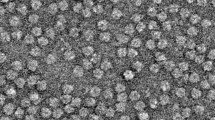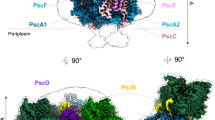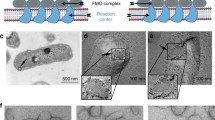Abstract
The trimeric nature of the Fenna–Matthews–Olson (FMO) protein antenna complex from green sulfur phototrophic bacteria was investigated. Mutations were introduced into the protein at positions 142 and 198, which were chosen to destabilize the intra-trimer salt bridges between adjacent monomers. Strains bearing the mutations R142L, R198L, or their combination, exhibited altered optical absorption spectra of purified membranes and fluoresced more intensely than the wild type. In particular, the introduction of the R142L mutation resulted in slower culture growth rates, as well as an FMO complex that was not able to be isolated in appreciable quantities, while the R198L mutation yielded an FMO complex with increased sensitivity to sodium thiocyanate and Triton X-100 treatments. Native and denaturing PAGE experiments suggest that much of the FMO complexes in the mutant strains pool with the insoluble material upon membrane solubilization with n-dodecyl β-d-maltoside, a mild nonionic detergent. Taken together, our results suggest that the quaternary structure of the FMO complex, the homotrimer, is an important factor in the maintenance of the complex’s tertiary structure.









Similar content being viewed by others
Abbreviations
- FMO:
-
Fenna–Matthews–Olson
- BChl:
-
Bacteriochlorophyll
- OD:
-
Optical density
References
Adolphs J, Renger T (2006) How proteins trigger excitation energy transfer in the FMO complex of green sulfur bacteria. Biophys J 91:2778–2797. https://doi.org/10.1529/biophysj.105.079483
Allen KD, Staehelin LA (1991) Resolution of 16 to 20 chlorophyll-protein complexes using a low ionic strength native green gel system. Anal Biochem 194:214–222
Ben-Shem A, Frolow F, Nelson N (2004) Evolution of photosystem I—from symmetry through pseudosymmetry to asymmetry. FEBS Lett 564:274–280. https://doi.org/10.1016/S0014-5793(04)00360-6
Bina D, Blankenship RE (2013) Chemical oxidation of the FMO antenna protein from Chlorobaculum tepidum. Photosynth Res 116:11–19. https://doi.org/10.1007/s11120-013-9878-2
Blankenship RE (2014) Molecular mechanisms of photosynthesis, 2 edn. Wiley/Blackwell, Chichester
Brixner T, Stenger J, Vaswani HM et al (2005) Two-dimensional spectroscopy of electronic couplings in photosynthesis. Nature 434:625–628. https://doi.org/10.1038/nature03429
Bryant DA, Costas AMG, Maresca JA et al (2007) Candidatus Chloracidobacterium thermophilum: an aerobic phototrophic Acidobacterium. Science 317:523–526. https://doi.org/10.1126/science.1143236
Dostál J, Pšenčík J, Zigmantas D (2016) In situ mapping of the energy flow through the entire photosynthetic apparatus. Nat Chem 8:705–710. https://doi.org/10.1038/nchem.2525
Fenna RE, Matthews BW (1975) Chlorophyll arrangement in a bacteriochlorophyll protein from Chlorobium limicola. Nature 258:573–577. https://doi.org/10.1038/258573a0
Fenna RE, Matthews BW, Olson JM, Shaw EK (1974) Structure of a bacteriochlorophyll-protein from the green photosynthetic bacterium Chlorobium limicola: crystallographic evidence for a trimer. J Mol Biol 84:231–240. https://doi.org/10.1016/0022-2836(74)90581-6
Frigaard N-U, Bryant DA (2001) Chromosomal Gene inactivation in the green sulfur bacterium Chlorobium tepidum by natural transformation. Appl Environ Microbiol 67:2538–2544. https://doi.org/10.1128/AEM.67.6.2538-2544.2001
Gallivan JP, Dougherty DA (1999) Cation-pi interactions in structural biology. Proc Natl Acad Sci 96:9459–9464. https://doi.org/10.1073/pnas.96.17.9459
Ghosh AK, Olson JM (1968) Effects of denaturants on the absorption spectrum of the bacteriochlorophyll-protein from the photosynthetic bacterium Chloropseudomonas ethylicum. Biochim Biophys Acta BBA 162:135–148. https://doi.org/10.1016/0005-2728(68)90221-1
Gottstein J, Scheer H (1983) Long-wavelength-absorbing forms of bacteriochlorophyll a in solutions of Triton X-100. Proc Natl Acad Sci 80:2231–2234. https://doi.org/10.1073/pnas.80.8.2231
Gottstein J, Scherz A, Scheer H (1993) Bacteriochlorophyll aggregates in positively charged micelles. Biochim Biophys Acta BBA 1183:413–416. https://doi.org/10.1016/0005-2728(93)90247-D
Herascu N, Kell A, Acharya K et al (2014) Modeling of various optical spectra in the presence of slow excitation energy transfer in dimers and trimers with weak interpigment coupling: FMO as an example. J Phys Chem B 118:2032–2040. https://doi.org/10.1021/jp410586f
Johnson SG, Small GJ (1991) Excited-state structure and energy-transfer dynamics of the bacteriochlorophyll a antenna complex from Prosthecochloris aestuarii. J Phys Chem 95:471–479. https://doi.org/10.1021/j100154a083
Kell A, Acharya K, Zazubovich V, Jankowiak R (2014) On the controversial nature of the 825 nm exciton band in the FMO protein complex. J Phys Chem Lett 5:1450–1456. https://doi.org/10.1021/jz5001165
Kell A, Blankenship RE, Jankowiak R (2016) Effect of spectral density shapes on the excitonic structure and dynamics of the Fenna–Matthews–Olson trimer from Chlorobaculum tepidum. J Phys Chem A 120:6146–6154. https://doi.org/10.1021/acs.jpca.6b03107
Li Y-F, Zhou W, Blankenship RE, Allen JP (1997) Crystal structure of the bacteriochlorophyll a protein from Chlorobium tepidum 1. J Mol Biol 271:456–471. https://doi.org/10.1006/jmbi.1997.1189
Li C, Wen A, Shen B et al (2011) FastCloning: a highly simplified, purification-free, sequence- and ligation-independent PCR cloning method. BMC Biotechnol 11:92. https://doi.org/10.1186/1472-6750-11-92
Namsaraev ZB (2009) Application of extinction coefficients for quantification of chlorophylls and bacteriochlorophylls. Microbiology 78:794–797. https://doi.org/10.1134/S0026261709060174
Olson JM (1994) Reminiscence about Chloropseudomonas ethylicum and the FMO-protein. Photosynth Res 41:3–5. https://doi.org/10.1007/BF02184138
Orf GS, Blankenship RE (2013) Chlorosome antenna complexes from green photosynthetic bacteria. Photosynth Res 116:315–331. https://doi.org/10.1007/s11120-013-9869-3
Pearlstein RM (1992) Theory of the optical spectra of the bacteriochlorophyll a antenna protein trimer from Prosthecochloris aestuarii. Photosynth Res 31:213–226. https://doi.org/10.1007/BF00035538
Rätsep M, Freiberg A (2007) Unusual temperature quenching of bacteriochlorophyll a fluorescence in FMO antenna protein trimers. Chem Phys Lett 434:306–311. https://doi.org/10.1016/j.cplett.2006.12.013
Saer RG, Blankenship RE (2017) Light harvesting in phototrophic bacteria: structure and function. Biochem J 474:2107–2131. https://doi.org/10.1042/BCJ20160753
Saer R, Orf GS, Lu X et al (2016) Perturbation of bacteriochlorophyll molecules in Fenna–Matthews–Olson protein complexes through mutagenesis of cysteine residues. Biochim Biophys Acta BBA 1857:1455–1463. https://doi.org/10.1016/j.bbabio.2016.04.007
Saer RG, Stadnytskyi V, Magdaong NC et al (2017) Probing the excitonic landscape of the Chlorobaculum tepidum Fenna–Matthews–Olson (FMO) complex: a mutagenesis approach. Biochim Biophys Acta 1858:288–296. https://doi.org/10.1016/j.bbabio.2017.01.011
Schmidt am Busch M, Müh F, El-Amine Madjet M, Renger T (2011) The eighth bacteriochlorophyll completes the excitation energy funnel in the FMO protein. J Phys Chem Lett 2:93–98. https://doi.org/10.1021/jz101541b
Thyrhaug E, Žídek K, Dostál J et al (2016) Exciton structure and energy transfer in the Fenna–Matthews–Olson complex. J Phys Chem Lett 7:1653–1660. https://doi.org/10.1021/acs.jpclett.6b00534
Tronrud DE, Wen J, Gay L, Blankenship RE (2009) The structural basis for the difference in absorbance spectra for the FMO antenna protein from various green sulfur bacteria. Photosynth Res 100:79–87. https://doi.org/10.1007/s11120-009-9430-6
Tsukatani Y, Wen J, Blankenship RE, Bryant DA (2010) Characterization of the FMO protein from the aerobic chlorophototroph, Candidatus Chloracidobacterium thermophilum. Photosynth Res 104:201–209. https://doi.org/10.1007/s11120-009-9517-0
Wahlund TM, Madigan MT (1995) Genetic transfer by conjugation in the thermophilic green sulfur bacterium Chlorobium tepidum. J Bacteriol 177:2583–2588
Wen J, Zhang H, Gross ML, Blankenship RE (2009) Membrane orientation of the FMO antenna protein from Chlorobaculum tepidum as determined by mass spectrometry-based footprinting. Proc Natl Acad Sci 106:6134–6139. https://doi.org/10.1073/pnas.0901691106
Wen J, Tsukatani Y, Cui W et al (2011a) Structural model and spectroscopic characteristics of the FMO antenna protein from the aerobic chlorophototroph, Candidatus Chloracidobacterium thermophilum. Biochim Biophys Acta BBA 1807:157–164. https://doi.org/10.1016/j.bbabio.2010.09.008
Wen J, Zhang H, Gross ML, Blankenship RE (2011b) Native electrospray mass spectrometry reveals the nature and stoichiometry of pigments in the FMO photosynthetic antenna protein. Biochemistry 50:3502–3511. https://doi.org/10.1021/bi200239k
Zhou W, LoBrutto R, Lin S, Blankenship RE (1994) Redox effects on the bacteriochlorophyll α-containing Fenna–Matthews–Olson protein from Chlorobium tepidum. Photosynth Res 41:89–96. https://doi.org/10.1007/BF02184148
Acknowledgements
This work was supported by the Photosynthetic Antenna Research Center, an Energy Frontier Research Center funded by the U.S. Department of Energy, Office of Science, Office of Basic Energy Sciences under Award Number DE-SC 0001035.
Author information
Authors and Affiliations
Contributions
REB and RGS designed the experiments. RGS and RS performed the experiments. RGS, RS, and REB analyzed the results. RGS and REB prepared the manuscript.
Corresponding author
Ethics declarations
Conflict of interest
The authors declare that they have no conflicts of interest with the contents of this article.
Electronic supplementary material
Below is the link to the electronic supplementary material.
Rights and permissions
About this article
Cite this article
Saer, R.G., Schultz, R.L. & Blankenship, R.E. The influence of quaternary structure on the stability of Fenna–Matthews–Olson (FMO) antenna complexes. Photosynth Res 140, 39–49 (2019). https://doi.org/10.1007/s11120-018-0591-z
Received:
Accepted:
Published:
Issue Date:
DOI: https://doi.org/10.1007/s11120-018-0591-z




